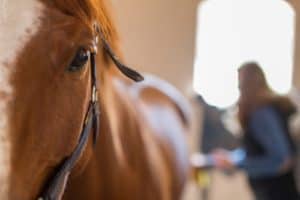
Big Problems for Equine Eyes
Horses have big eyes—which can lead to big problems. Learn how to recognize common signs of eye injuries and what to do about them.


Horses have big eyes—which can lead to big problems. Learn how to recognize common signs of eye injuries and what to do about them.

Routine health monitoring and broader testing helped veterinarians identify an outbreak quickly.

Donkeys have similar dental structures as horses, and they’re at risk of developing many of the same kinds of dental issues. But, unlike horses, their problems often go overlooked—and that’s to their detriment, according to donkey specialists.

Horses lose large quantities of sodium, potassium, and chloride, as well as smaller amounts of magnesium and calcium, through their sweat. Supplementation before work might help.

Researchers studied which eye horses used to look at new objects. Their findings were unexpected.

A donkey and mule expert offers tips for veterinarians on how they can best approach, handle, and read their nonhorse equid patients.

Study: Worry wrinkles, known to show pain in horses, are also present during stressful events.

Researchers found the choice of steroid used for sacroiliac joint injections predicted outcomes better than whether the horse underwent a preprocedure ultrasound.

Researchers found sound horses’ movement didn’t change when traveling on straight, flat surfaces after undergoing foot nerve blocks.

Researchers found treating all horses on a farm four or six times a year with moxidectin or ivermectin makes worms develop anthelmintic resistance two to three times faster than other recommended programs.

Domestication is relatively new to horses, which is why two Italian researchers are urging competitive riders to allow their horses to engage in natural behaviors.

Vesicular stomatitis primarily affects horses, cows, and pigs, causing fever, drooling, and blisters on the mouth, lips, nose, coronary bands, and teats.

While each horse is different, here are some common behavioral signs that can help you tell if your horse is happy, sick, or painful, as well as keep you safe.

Standardized helmet tests measure the equipment’s reaction to hitting a steel anvil, but equestrians usually fall on softer, less rigid surfaces.

Researchers found individual horses can have such widely different vertebral columns, they don’t even have the same number of vertebrae.

A survey found most veterinarians who specialize in horses and primarily deal with lameness issues use nonsteroidal intra-articular joint therapies in their patients.
Stay on top of the most recent Horse Health news with